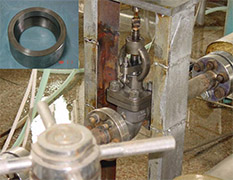
Superalloys are the key materials of aero-engines, and nickel-based and nickel-iron-based superalloys are an important part of the current superalloy structural materials. Nickel-based superalloys are called because of their good heat resistance and corrosion resistance. As the "heart of aero-engine", it also has the advantages of stable structure, high working temperature and strong alloying ability. , atomic energy industry and ground turbines have been widely used. Next, let's learn about the performance and composition characteristics of high-temperature alloy welding, and hope to help you!
Low-expansion superalloys have the common function of combining high strength and low expansion coefficient, and also have good cold and heat fatigue function, thermal shock resistance, and high pressure hydrogen embrittlement resistance.
We can roughly divide low-expansion superalloys into four categories:
1. The first category is Nb-containing low-expansion superalloy, which includes Incoloy903 and Pyroment CTX-1 and domestic GH903. Such alloys are based on Fe-Ni-Co, and are strengthened by adding elements such as Nb, Ti, and Al.
2. The second category is Al-reducing low-expansion superalloy, which includes Incoloy907 and CTX-3 and domestic GH907. In order to improve the stress resistance and accelerate the grain boundary oxidation brittleness, the content of Al in these alloys is restricted to be less than 0.1% (mass fraction), and the content of Nb is appropriately increased.
3. The third type is high Si low expansion superalloy, which includes Incoloy909 and CTX-909 and domestic GH909. This type of alloy is a modification of the Al-reducing and low-expansion superalloy, and its basic composition is the same, only the Si content is increased.
4. The fourth category is oxidation-resistant low-expansion superalloys. The existing research on low-expansion superalloys is mainly concentrated on Incoloy903. There are relatively few researches on Incoloy907 and Incoloy909. Domestic research has been done on liquefaction cracks in the heat affected zone of GH907 welding. The research on the weldability of GH909 has not yet been reported. Ernst et al. investigated the weldability of Incoloy903, Incoloy907 and Incoloy909 using point and small variable restraint experiments. The results show that the relative susceptibility of these alloys to heat-affected zone (HAZ) liquefaction cracks and weld crystallization cracks is ranked Incoloy903
To sum up, the current research on the weldability of low-expansion superalloys mainly stays at the stage of qualitatively studying crack susceptibility from the metallurgical point of view using microscopic analysis methods and weldability experiments. It is one of the important research directions of material weldability research to introduce the welding process evolution and stress-strain numerical simulation into welding cracks.


 Language
Language  中文简体
中文简体 English
English


 Address:A No.13 Twenty-third Road, South Economic and Technological Development Zone, Shenyang City, Liaoning Province.
Address:A No.13 Twenty-third Road, South Economic and Technological Development Zone, Shenyang City, Liaoning Province. Phone:13898848281
Phone:13898848281 Landline:024-25799905
Landline:024-25799905 Fax:024-25799905
Fax:024-25799905 E-mail:jyjg2018@163.com
E-mail:jyjg2018@163.com